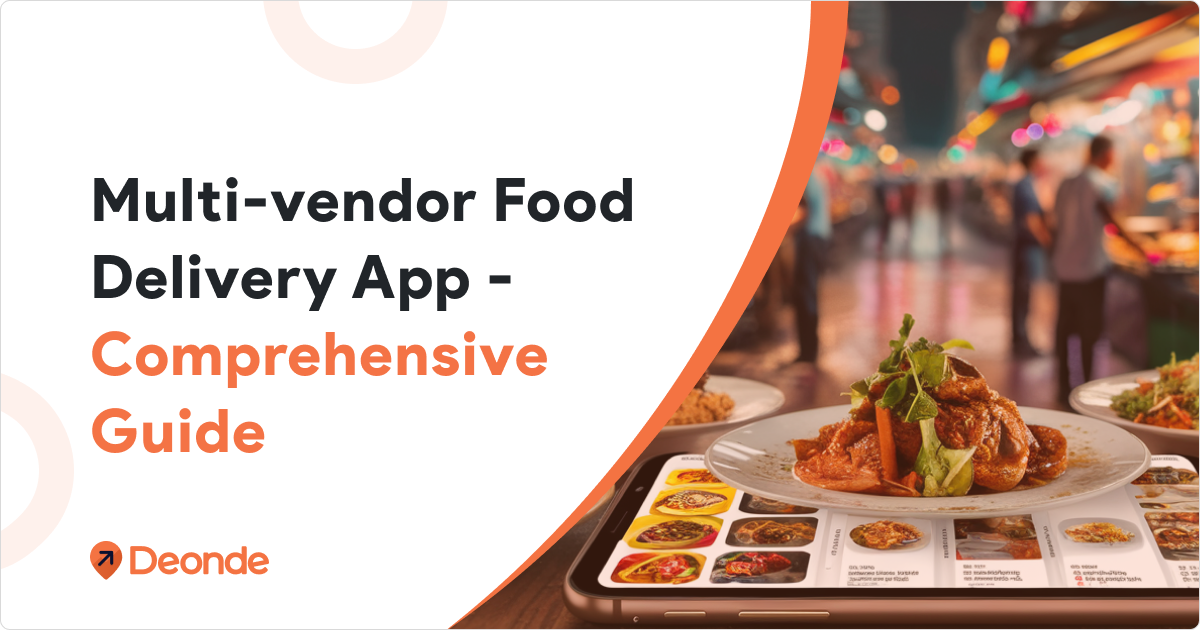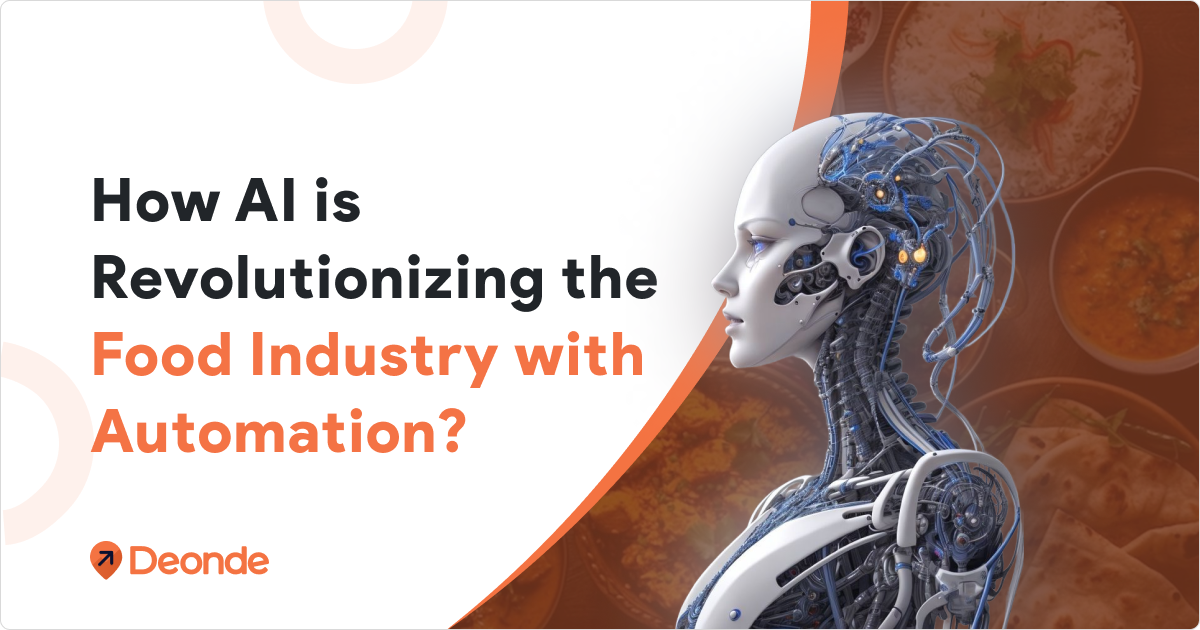Did you skip breakfast today? Or are you craving an evening snack? Either way, order food through your phone and deliver it to you—no matter where you are!
Food tech apps have become indispensable parts of our lives. Uber Eats, Zomato, and Swiggy have become household names. They have brought incredible convenience, as we can now enjoy meals from a wide selection of restaurants with just a few clicks!
To Build a Multi-vendor Food Delivery App like this, usually partner with more than one restaurant vendor. As a result, consumers can browse and order from multiple restaurants through a single application.
So, if you’re new to the world of food delivery apps and need a helping hand, this Multi-restaurant Food Ordering and Delivery System guide is the best place to start.
Here, we’ll understand the purpose, features, advantages, and cost of developing a multi-vendor food delivery app. So, let’s dive right into it!
What is a Multi-vendor Food Delivery App?
What seems like a very dense industry jargon is a rather technical term for those food order and delivery apps we know so well.
A multi-vendor food delivery app is like a virtual food court.
It is an app that allows multiple restaurants to sell food to consumers from a single platform.
Consumers can browse menus of different restaurants, place orders, and have restaurant-ready meals delivered through such apps.
For instance, apps like UberEats, Grubhub, Zomato, and Swiggy work along the same model. They partner up with multiple local restaurants and facilitate sales through the app.
Overview of the Multi-restaurant Food Delivery Marketplace
The online food delivery space has experienced unprecedented growth after the COVID-19 pandemic. Under quarantine, most people had no choice but to order food using mobile applications.
Despite the return of dine-in options, people still prefer food delivery over dining-in. This changing consumer behavior has opened up a vast market for the business of food delivery apps.
According to Statista, in 2023, the food delivery revenues worldwide shot up to a whopping one trillion USD. Consequently, the user base of online food delivery platforms also witnessed massive growth, with over 3 billion consumers globally.
Hence, the global Online Food Delivery Application Market is ripe, worth almost 5.12 billion USD. With a staggering CAGR of 10.4%, the market will surmount to USD 9.28 billion by 2028.
Despite the presence of big players in this space, there are several underserved geographies and verticals to explore.
Hence, if you’re thinking of developing a multi-vendor food delivery mobile application–the perfect time to do so is now!
Advantages of Building a Multi-vendor Food Ordering & Delivery App
A franchise food delivery app or a single-vendor food delivery app will have limited scope.
Single-model vendors usually have a single contractor and sell only a limited range of food items on the platform. While it’s easier to manage menus and delivery logistics within this model, the consumer base is thin.
On the other hand, a multi-vendor food delivery app allows multiple restaurants to conduct business on a single interface. As a result, this model is certainly more advantageous:
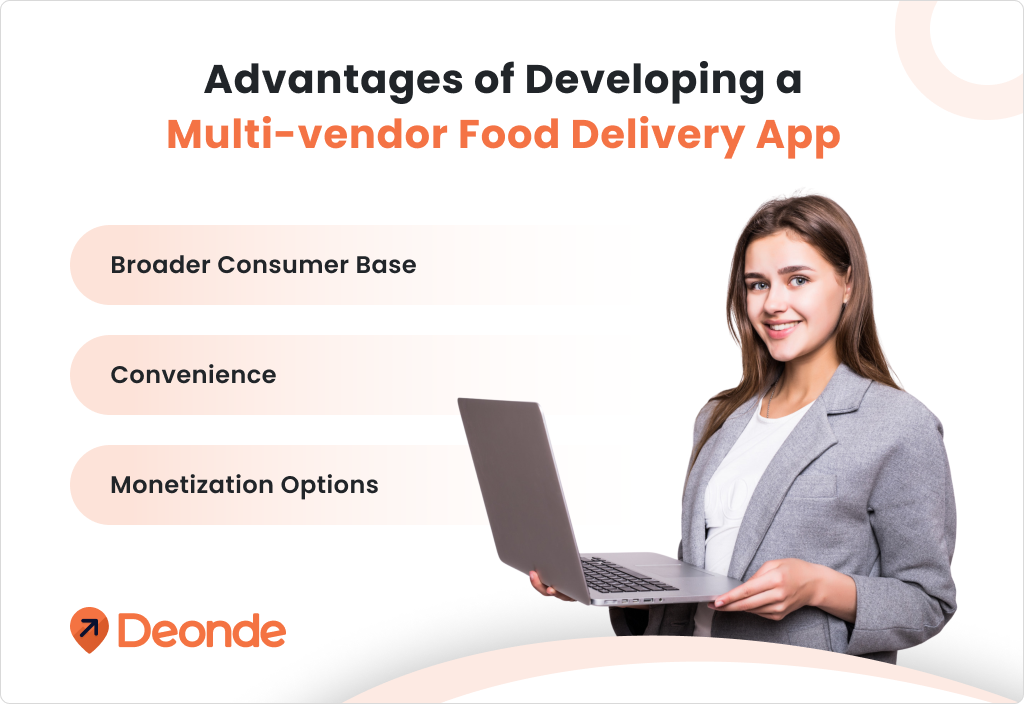
Broader Consumer Base
With multiple restaurants onboard, consumers have a wide range of menus that can serve audiences with different cuisine preferences. Meaning, a wider target audience can be served.
Convenience
The centralization of food options makes it easier for consumers to order a variety of delectables without downloading multiple apps. Multi-restaurant food ordering app allows consumers to order from different restaurants in a single transaction.
Monetization Options
Under this model, multiple competing restaurants are available on a single platform. Multiple revenue streams can be generated by offering premium placements for a higher fee or paid display advertising.
Developing a multi-vendor food ordering system is a win-win situation for all. It eases users’ access, provides a wider target segment for restaurants, and raises the platform owner’s commission rates.
How Does a Multi-vendor Food Delivery App Work?
There are multiple stakeholders involved in the multi-vendor food delivery ecosystem. So, let’s understand how this model of food delivery works:
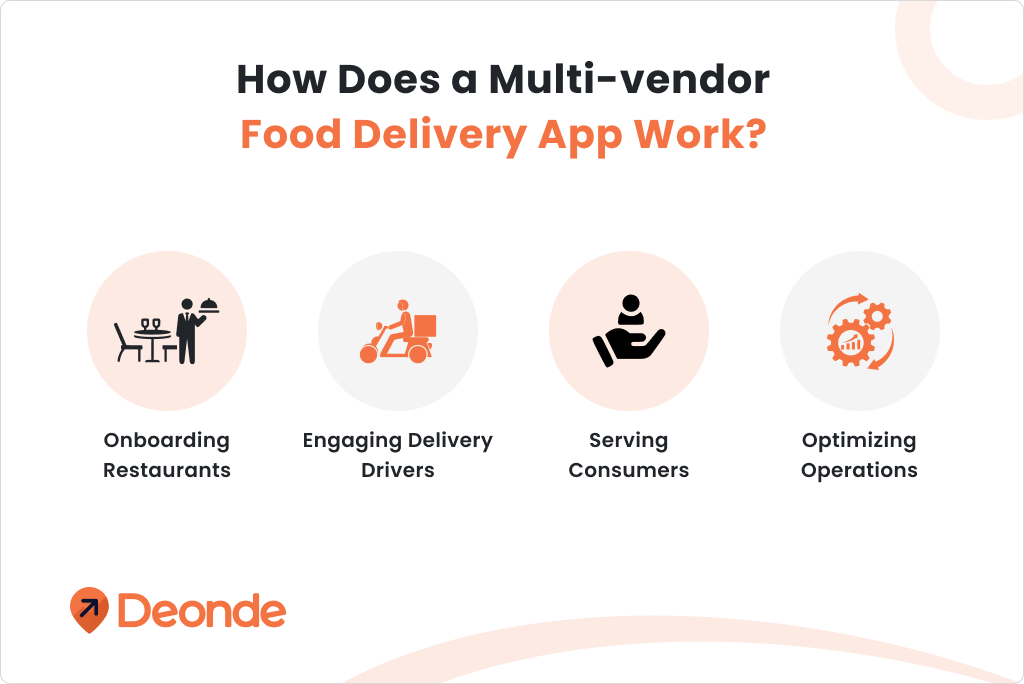
- Step 1: Onboarding Restaurants
Restaurants are crucial to your multi-vendor food delivery app, so we start by onboarding restaurant vendors.
Partnered restaurants can set up their profile, menus, photos, and contact information. With menu-management tools, restaurants can edit, add, or delete menu items when needed.
They also receive notifications when an order is placed and can track it until the food is delivered.
- Step 2: Engaging Delivery Drivers
You’ve got food cooking at the restaurants. This food needs to be delivered to the consumers via delivery drivers.
Hence, the next step is to register drivers on the app. Delivery drivers should have access to pickup and drop-off locations.
The key here is to foster seamless communication between the restaurant and delivery drivers.
- Step 3: Serving Consumers
Your app is thriving with multiple restaurants. Delivery Drivers are waiting.
The next step is to reach out to consumers who browse menus, place orders, pay, and track their deliveries.
- Step 4: Optimizing Operations
With an influx of orders and payments, you will need an admin panel to streamline workflow processes.
The admin app allows you to access consumer data, revenues, and order analytics. This analysis can help with strategic planning and growth.
As you can see, a multi-vendor food delivery app facilitates multiple restaurants to consumers and delivery drivers.
How DeOnDe Works: A Comprehensive Overview of Features, Pricing, and Process
Hence, creating a platform that’s easy on the eyes and user-friendly is a must. But that’s not all. You need several other features to launch a successful multi-vendor food ordering app.
Let’s look at those.
Must-have Features of a Multi-vendor Food Delivery App
In the business of food delivery, every stakeholder—customer, restaurant, drivers, and admins—must have their own app. Since the role played by everyone involved is very different, the features of their apps will also be inherently different.
Hence, we’ve listed essential features for the Multi-vendor Food Delivery App for each of these apps:

1. Essential Features of Customer App
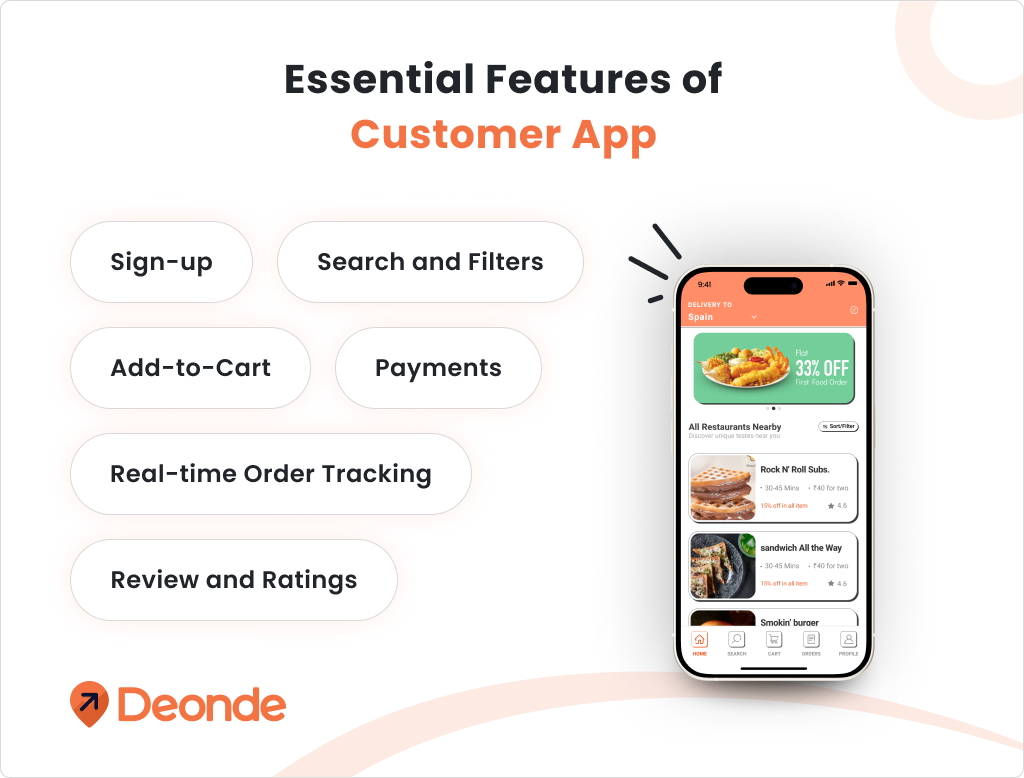
- Sign-up
This is probably the most important feature, as it’s a new consumer’s first action. The key here is to help users set up their profile (with contact and address information) with minimal effort.
Complex registration processes can turn off users even before they use your app.
- Search and Filters
Since we have multiple restaurants on our app, we equip the app with search and filters to sort menus by cuisine, diet preferences, allergies, price range, restaurant ratings, location, and working hours.
This will enhance their browsing experience and can expedite order placements.
- Add-to-Cart
Now that our users know what they want, they must add their food items to a virtual cart. Users should be able to edit cart items before checkout.
This allows users to recheck their orders, considerably reducing ordering errors or complaints.
- Payments
Only trust will get you a higher repeat order rate!
Hence, build a trustworthy interface by providing secure payment gateways.
Provide multiple payment options, such as debit cards, credit cards, UPI, QR, and COD. Also, implement industry-standard security measures to protect CVV numbers, credit card numbers, and UPI IDs.
- Real-time Order Tracking
Make sure customers stay informed through live updates on their orders. Update delivery times on the app if the driver is stuck in traffic or there is some restaurant delay.
- Review and Ratings
Make your consumers feel heard by allowing them to rate restaurants and delivery drivers.
Good Reviews and Ratings can drive traffic and provide confidence to new customers to place their first orders.
2. Essential Features of Restaurant App
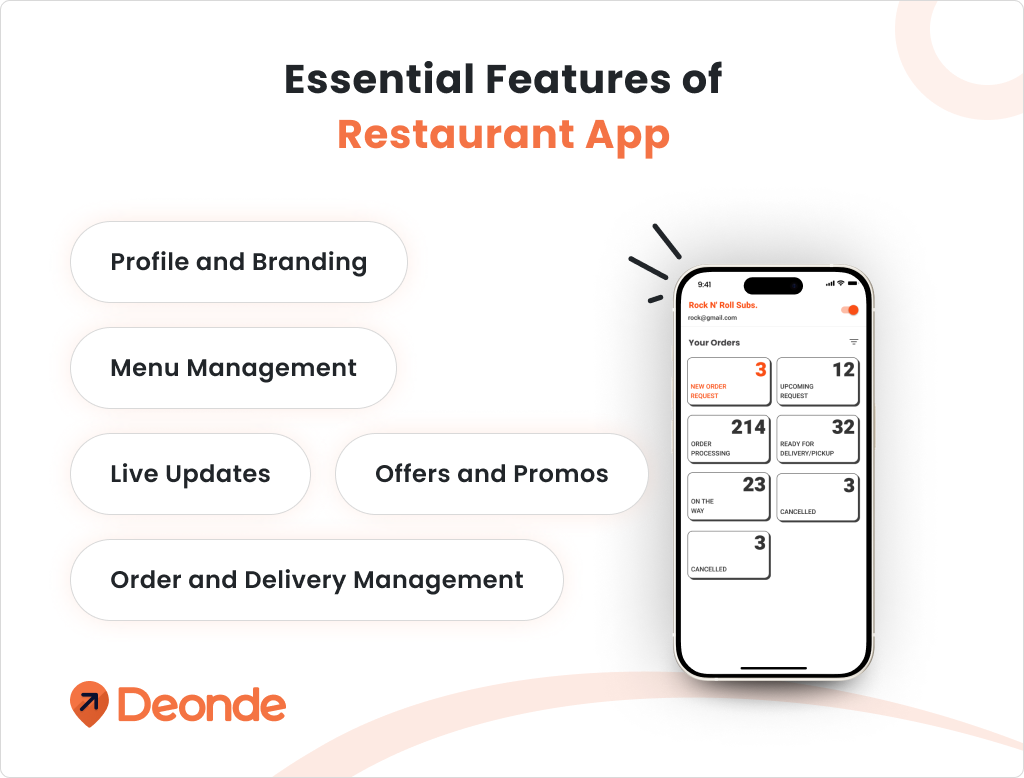
- Profile and Branding
Enable restaurants and vendors to set up shop with brand logos, taglines, locations, and contact information. This way, consumers will be able to identify and find their favorites on your food-ordering app.
Also, allow room for restaurants to display their opening and closing times.
- Menu Management
Menu management includes tools that allow restaurants to create and edit intuitive menus. Menus should be coupled with high-res original images.
Updated, easy-to-read menus give restaurants a better edge over the competition.
- Offers and Promos
Some restaurants may offer festive discounts or weekend specials to encourage sales. Your app should allow restaurants to post such a Promo Code Coupon.
- Live Updates
Restaurants should be able to communicate the status of food preparation to the consumers through quick Chat Notification Solutions like Order received, In preparation, Ready for pickup, and Out for delivery.
- Order and Delivery Management
Allow restaurant vendors to review historical orders, successful deliveries, and payments with Customer Order Management for Restaurants.
3. Essential Features of Driver App

- Driver Registration
Allow drivers to set up their user profiles quickly. Create intuitive fields to help them fill out their details.
- GPS navigation
Equip your drivers with navigation tools so they can deliver food from the restaurants to the consumers seamlessly.
- In-app Communication
A delivery driver has a flat tire, and it is stuck on the road.
Lack of in-app communication will result in the restaurant not knowing why the delivery was late and the consumer becoming infuriated.
Avoid this with in-app messaging or phone call features.
- Earnings
Drivers should be able to check the orders they’ve successfully delivered and track their daily, weekly, and monthly earnings with Driver Payment Settlement Software.
4. Essential Features for the Admin Panel

- Customer Management
An intuitive analytics suite that gives insights into customer details, orders, concerns, and preferences.
- Delivery Management
Through this module, you’ll be able to track all deliveries—especially late or missed deliveries!
- Analytics and Reports
Because this is a multi-vendor food delivery app, thousands of orders will pour in daily. It will be impossible to keep track of all these numbers.
Hence, an intuitive dashboard with AI-enabled widgets will boost your productivity and give you impeccable insights to boost your business with Data Analytics & Management Solutions!
- Driver Management
An information panel that stores all delivery staff-related data, including their profile, account details, and payroll, with Delivery Management Software.
Cost of Developing a Multi-restaurant Food Delivery App
Building a multi-restaurant food order and delivery app from scratch is complex.
It takes about 550-800 hours to develop and can cost anywhere from a few thousand dollars (~ $10,000) to a whopping several thousand dollars (~ $215,000).
Where you fall within this range will depend on a range of factors, like extra features, design complexity, and choice of platform.
However, you can kick-start your food delivery app business with Deonde Express – A Multi-vendor Food Ordering System. Deonde’s multi-vendor delivery suite is customizable and highly scalable. This means you’ll be able to launch your app with Deonde in less than a week!
Unlike other service providers, Deonde doesn’t require you to make hefty upfront investments. Start with just $199/month or less. And this includes all essential features, maintenance, and server costs!
Things to Consider While Choosing the Right Multi-vendor Food Delivery App Solution
You might want to explore white-label food delivery applications to launch your multi-vendor food delivery app quickly. Such solutions are cost-effective and deployment-ready.
With the right solution, your multi-restaurant food ordering and delivery app could be up and running in weeks.
But here are a few Things to Consider While Choosing the Right Multi-vendor Food Delivery App Solution:
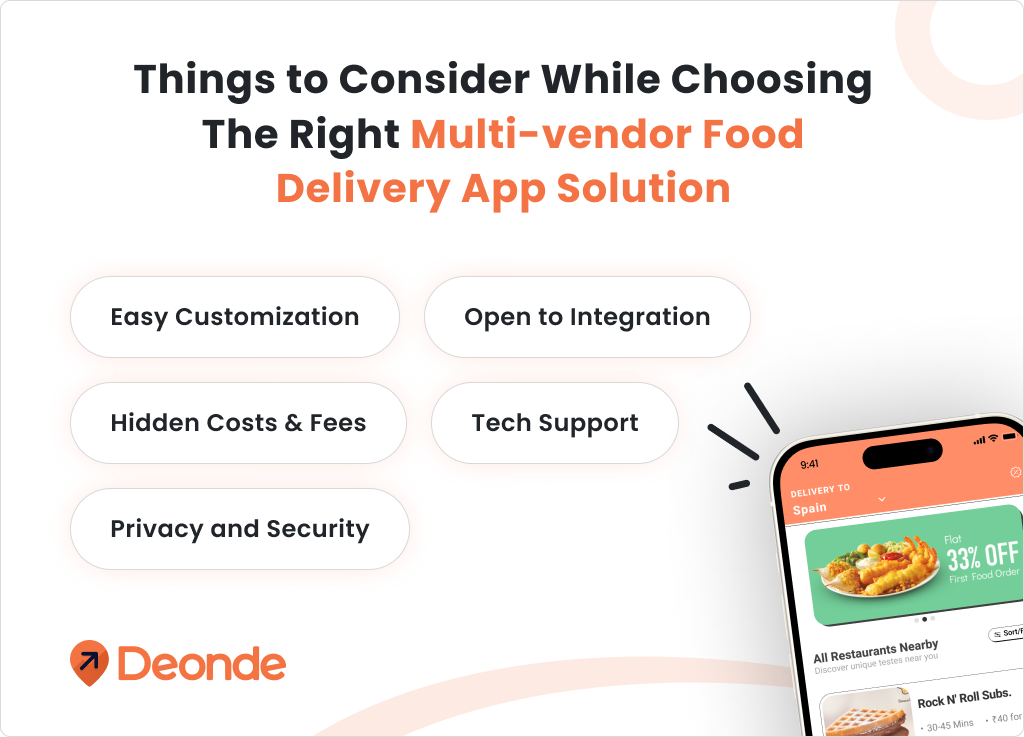
- Easy Customization
You must customize the chosen white-label app’s layout, style, theme, and even features to reflect your taste and brand.
After all, good branding will increase your app’s perceived value and attract more consumers.
- Open to Integrations
Select a solution that allows seamless integrations to vendor CMS or POS. Integrations are powerful as they render higher flexibility and scalability to multi-vendor food delivery operations.
- Hidden Costs & Fees
Work with a solution provider that’s transparent with costing and subscription fees.
For instance, feature add-ons or API integrations may cost extra. Ad hoc costs like server/hosting fees, maintenance charges, and support costs should also be considered.
Hence, it is essential to understand the pricing structure entirely before committing. Work with a solution provider that promises long-term partnerships and is transparent about its pricing structure.
- Tech Support
System hiccups can negatively affect your revenue and brand name. Hence, always consider choosing a solution that offers constant technical support.
This way, the tech-support team can resolve issues and bugs, creating a seamless experience for your app users.
- Privacy and Security
Data security should always be a priority. Ensure your solution has all the industry-standard data security measures to avoid infringement or PII leaks.
ALSO READ: Multi-Restaurant Ordering System- Factors to Consider Before Selecting
Top Multi-restaurant Food Ordering & Delivery Apps
You’re here! This means you now have a solid understanding of multi-vendor food ordering apps. So now, it’s time to inspire you with examples of companies who’ve built a fortune with food delivery apps:
Take a look at some of the top multi-restaurant online ordering apps:
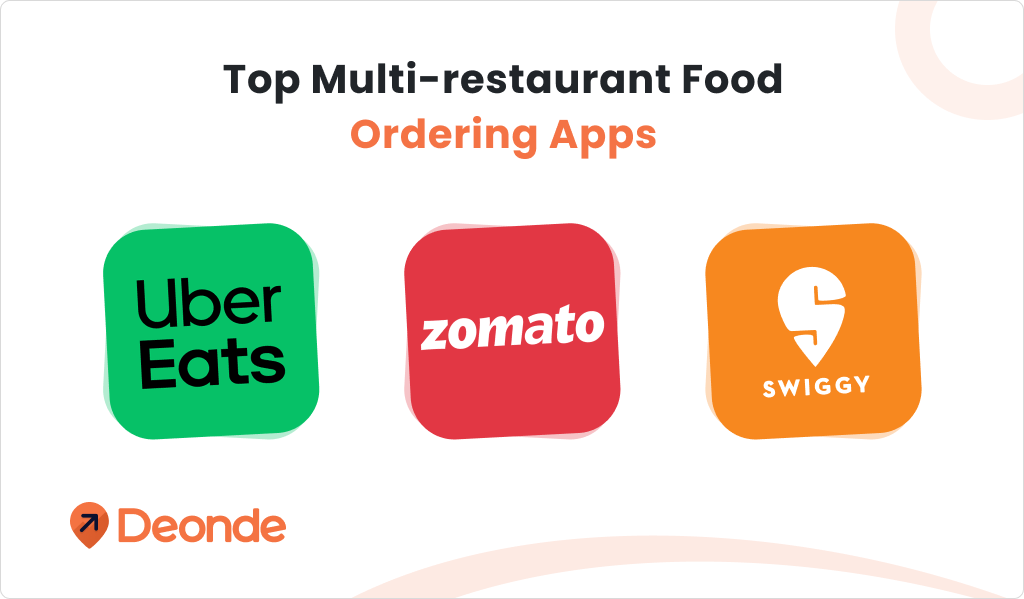
UberEats
Uber Eats began as a spin-off business. A small pilot program that started in Los Angeles in 2014 has grown to dominate the food order and delivery space. As of January 2024, Uber Eats controls 23 percent of the online food delivery market in the United States.
Zomato
In 2008, Zomato began its journey as a restaurant listing website. 16 years later, it has become India’s leading food delivery and restaurant discovery app. In 2023, Zomato recorded massive revenues of over 86.9 billion INR! Zomato has over 1M+ downloads on Google Play alone, with an average rating of 4.7 stars. It’s available in 1000+ Indian cities and has over 3 lakh partner restaurants.
Swiggy
A very close competitor to Zomato, Swiggy has also emerged as a popular multi-restaurant online food delivery app in India. It began in 2014 and is now available in more than 500+ Indian cities. Today, Swiggy has partnered with 160,000 Indian restaurants and has 20 million active users.
Final Insights
The change in consumer habits past COVID-19 has created a huge market for the business of food delivery through mobile apps.
After all, a well-designed multi-vendor food delivery app can be a win-win for all. Consumers can order and receive food without leaving their houses, while restaurants reach a wider audience and scale revenues. You can facilitate this process and establish a successful business.
But to get started, you need to choose the right resources. Developing a food order & delivery app from the ground up is a massive task. But don’t feel discouraged. There are several food delivery solutions at your disposal. And this is where we can help you!
Consider Deonde, a white-label food delivery app solution that can be customized to your liking. With constant tech support, easy usability, and 99.99% uptime–your success is guaranteed with Deonde.
So, what are you waiting for? The time to make an impact is now!
Connect with Deonde and take the first step to developing your very own multi-vendor food delivery app.
Frequently Asked Questions ( FAQ’s )
1. Does Deonde Offer Multi-language Support?
Yes, we do. With our multi-restaurant food delivery solution, you can offer support in multiple national and international languages. Speak in the language of your customers and create better customer experiences.
2. What Is a Referral System? How Does it Work?
Our multi-restaurant food delivery solution comes with an inbuilt referral system. This is a marketing tool that can promote and popularize the app. It works by offering generous rewards to any user who refers the app to a friend or a family member.
3. What’s the Monthly Subscription Payment Model?
Under this payment model, you’ll be able to rent iOS and Android mobile on-demand multi-restaurant delivery apps on a monthly basis. By renting such a white-label solution, you can launch your multi-delivery business quickly without any huge upfront investment.
4. I’m a Bakery Owner. Can I Still Opt for Deonde’s White-label Multi-vendor Delivery Suite?
Yes, absolutely! All Deonde white-label solutions are entirely customizable. You can alter layouts, fields, logos, and more. Deonde has worked with various multi-vendor delivery startups, cloud kitchens, multi-chain restaurants, grocery stores, and more. So yes, we’re confident that we can also help you with your bakery delivery needs!

